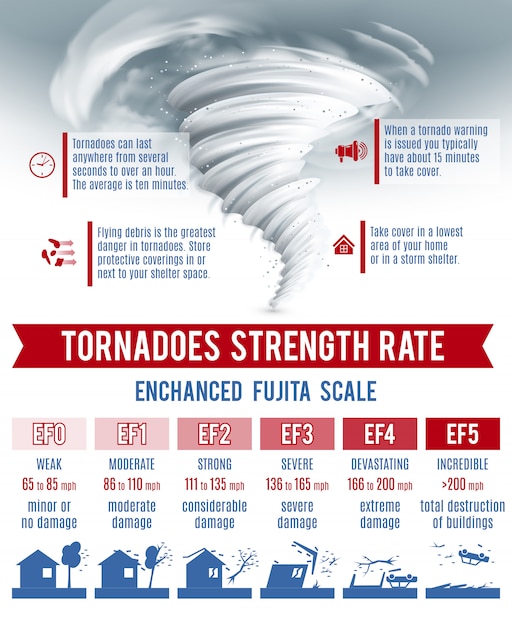10 Fascinating Facts about Tornadoes

Tornadoes are rotating columns of air that can reach speeds of over 300 miles per hour.
The United States experiences more tornadoes than any other country in the world.
Tornadoes can form from severe thunderstorms when there is a change in wind direction and an increase in speed with height.
The strongest tornadoes can cause devastation along a path up to a mile wide and 50 miles long.
Tornadoes can occur in any season, but they are most common during spring and early summer.
Tornadoes have different shapes, including funnel-shaped, rope-shaped, and wedge-shaped.
The width of a tornado can vary from just a few feet to over a mile wide.
Tornadoes can last for just a few minutes or for several hours, depending on the storm’s intensity.
Tornadoes can appear in a variety of colors, including white, gray, black, and even red or green.
The area where tornadoes are most likely to occur in the United States is known as Tornado Alley.
Tornadoes can travel at an average speed of about 30 miles per hour but have been recorded to move as fast as 70 miles per hour.
The Fujita scale, ranging from F0 to F5, is used to measure tornado intensity based on the damage they cause.
The deadliest tornado in history occurred in Bangladesh in 1989, claiming the lives of an estimated 1,300 people.
Tornadoes can generate multiple vortices that orbit the main funnel cloud, known as satellite tornadoes.
10 Fascinating Facts about Tornadoes part 2
Tornadoes can produce winds strong enough to lift cars, demolish buildings, and uproot trees.
The term tornado comes from the Spanish word tornar, which means to turn.
The speed at which a tornado rotates is highest near the ground and gradually decreases as it moves upward.
Tornadoes can have a hissing or roaring sound that is caused by the intense winds rushing through the funnel.
Tornadoes can form over water and are then known as waterspouts.
Tornadoes can create a low-pressure zone, leading to a sudden drop in atmospheric pressure.
Tornadoes often occur at the edge of severe thunderstorms called supercells.
Tornadoes can cause a phenomenon called green sky due to sunlight passing through hail and illuminating the clouds.
Some tornadoes spin counterclockwise, while others rotate clockwise, depending on the location in the world.
Tornadoes can generate intense lightning within the storm, contributing to their destructive power.
Tornadoes are not always visible as they form but can appear suddenly when they pick up dust or debris.
Tornadoes can travel over hilly or even mountainous terrain, contrary to popular belief.
Tornadoes have been reported on every continent except Antarctica.
Tornadoes can create small whirlwinds of fire, known as fire whirls or fire tornadoes.
The largest tornado outbreak in a single day occurred on April 27, 2011, when a record-breaking 358 tornadoes touched down over a 24-hour period.
Tornadoes in the Southern Hemisphere tend to occur more frequently between November and April.
The longest-tracked tornado in history traveled 219 miles across the state of Illinois in 19
Tornadoes can generate hailstones of various sizes, with larger tornadoes capable of producing hailstones larger than baseballs.
Tornadoes can cause a sudden drop in temperature as they pass through an area.
Tornadoes have been reported to lift animals, such as fish and frogs, from bodies of water and then deposit them elsewhere.
Tornadoes can create a visually striking phenomenon known as a stovepipe tornado due to their cylindrical shape.
Tornadoes can cause a high-pitched sound similar to a freight train or a jet engine.
Tornadoes can be witnessed from a safe distance by looking for rotating clouds or a rotating column of debris near the ground.
Tornadoes can cause electrical power outages due to downed power lines and damage to electrical infrastructure.
Tornadoes can lead to the formation of rainbows due to sunlight passing through the rain-filled air behind the tornado.
Tornadoes can create a vacuum effect, resulting in objects being sucked into the vortex.
Tornadoes have been observed to completely remove the bark from trees along their paths, a phenomenon known as debarking.
Tornadoes can generate intense winds that can destroy wind turbines, which are designed to harness wind power.
Tornadoes can cause rapid pressure changes, resulting in eardrum damage or rupture in some cases.
Tornadoes can be difficult to predict accurately, but advance warning systems have improved significantly in recent years.
Tornadoes can be a subject of scientific research, with storm chasers and meteorologists studying them to better understand their formation and behavior.

